Do you know how to hook punch with power… and not injure your shoulder? I didn’t!
I admit it… I once tore my shoulder throwing wild hooks—too wide, too hard. During rehab, I swore I’d never throw a hook again.
But over time, I realized the problem wasn’t the hook punch, it was my lousy technique. That’s when I figured out a simple way to fix my form and throw a safer, stronger hook. I hope it helps you, too!
If the video doesn’t play, you can find a summary below. Take it slow and steady! 🙂
How to Hook Punch with Power
The hook punch is one of the most effective knockout shots in fighting. But when people throw it, one of the biggest mistakes you see is using too much shoulder.
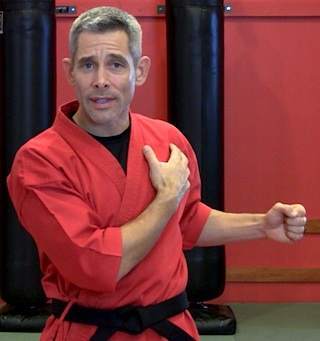 Winding up the arm not only puts your shoulder in danger of being injured, it puts your chin in danger of being hit!
Winding up the arm not only puts your shoulder in danger of being injured, it puts your chin in danger of being hit!
My advice? Train your hook punch from the ground up instead of the fist down.
How do you do that?
Throw an elbow!
That’s right. The best way to develop a strong hook punch is to not throw a hook punch… throw an elbow instead.
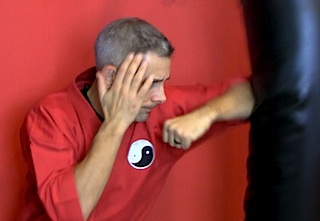
That may sound crazy, but for me, throwing an elbow feels exactly the same as throwing a short hook. In fact, I consider the elbow strike a test…
If you can’t throw an elbow with balance and power, then you’re not ready to throw a hook punch. Get the elbow right first!
Here’s what I mean by “getting it right”…
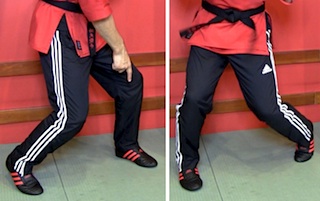
Start with your feet. Make sure your front foot pivots.
You can shift your weight to the other foot or just “sit down” on the punch, but make sure you turn that foot!
Pop your knee. I like to imagine someone kicking behind my leg, causing my knee to explode forward. A little imagination adds a lot to the pivot!
Rotate the hips. If you’re wearing a martial arts belt, it’s easy to see if you’re rotating the hips or not. Make that belt flip and flop.
Raise your shoulder a little. But don’t lift it out of the socket! It should feel comfortable when you make contact.
Keep your chin down.
Keep your guard up.
Breathe on every strike.
Once all of that feels good and you can slam the heavy bag with your elbow, it’s time to add the hand and practice the hook punch. Use the same body movement as before, but instead of leading with your elbow, lead with your fist.
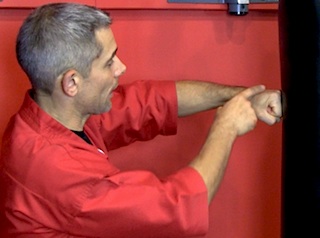
As you make contact with the bag, make sure your elbow is lined up behind your fist and your wrist is straight. You don’t want to put all your power into a bent wrist. Ouch!
Start off with a short hook. Remember—don’t wind up your arm. Just let your hand lead the pivot.
After you feel your short hook is strong and balanced, then open up the range and extend the punch.
To make your hook even more devastating, try throwing the elbow right behind it! That gives you two hits in one motion—fist > elbow. That’s illegal in boxing, but great for self-defense.
Two more tips…
First tip: To add even more power, wind up your body, not your arm. How?
- Wind up your body by slipping to the side, then hooking back.
- Wind up the body by throwing a straight punch or cross. Punching with one hand winds up the other hand.
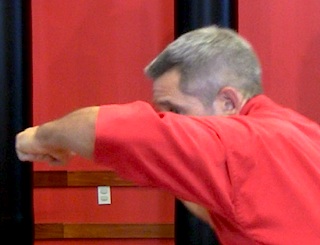 Whatever you do, be sure to keep your guard up and power the punch from the core, not the shoulder.
Whatever you do, be sure to keep your guard up and power the punch from the core, not the shoulder.
Second tip: You’ll hear a lot of different opinions about the proper way to position your fist on the hook. If you saw my video, How to Punch in a Street Fight, you know for me, the best fist is the one that fits the target.
But as a general rule, I always want to position myself in a way that minimizes tension in my muscles. That means I follow the natural lines of motion in my body. In that spirit…
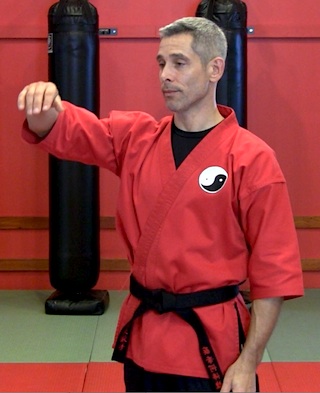 If you stand naturally with your arm hanging down, you’ll notice your thumb points up. As you lift your arm, your thumb faces you. As you raise your arm higher, it begins to dip down.
If you stand naturally with your arm hanging down, you’ll notice your thumb points up. As you lift your arm, your thumb faces you. As you raise your arm higher, it begins to dip down.
So, following the natural motion of the arm, when I hook to the body, my thumb tends to be up. A little higher, my thumb faces me. Higher than that, my thumb starts to dip down.
Thumb issue aside, my biggest concern is fitting what I’m hitting so that my elbow is always behind my fist, my wrist is straight, and my knuckles hit as flush as possible. That’s the secret to a good hook punch.
Now you know how to hook punch with power. Give it a try! 🙂

Another great one Sensei! I really appreciate videos on the basics. I’m a latecomer to martial arts (almost 50 when I started a few years ago) and the arts I train in are usually “seconds” for most MA practitioners so not a huge emphasis on the basics in day-to-day training (a lot of prior knowledge is assumed). My new year’s resolution is to get private lessons to improve my basics but these videos are super helpful as well. Thanks!
RoseAnne! How cool are you? You’re also smart for staying focused on basics. Advanced techniques are just basics done better!
I also find that having your gross motor, large movements locked down will give you a solid platform for the fancier stuff yet to come. I see many so-called “advanced” practitioners failing at higher levels because their basics simply aren’t strong enough.
Keep up the good fight, RoseAnne! The best of all things in the new year! 🙂
RoseAnne,
I, too, didn’t start until I was older. I applaud the desire to master the basics. Private lessons can be very helpful (and Sensei Ando’s vids/website is a gold mine of information.) Ask your instructor to include your hard work in class, as well. Getting the basics, but not being able to practice them/apply with various partners can be frustrating. I salute you!
Thanks for your support, as always! Let’s all make this the best year ever! Well, until 2017 anyway! 🙂
EXCELLENT!!!!!!!!!!!!!
THANK YOU!!!!!!!!!!!!!! 🙂
a major doubt cleared
thanks a lot sir
You’re welcome, Sriram!
wow this is so helpful! Not just the overall concept, but the way you break it down into such tiny parts, e.g. what to do with your chin and your knee etc etc . . .
I’m so glad you found it helpful! Thanks very much for the comment, Kai! OSU!
Yes the basics are simple but if you get careless the pain begins.
Sometimes older more experience folks can get careless. Time to go back on the basics. Thanks for the tips Sensei Mierzwa.
Thanks for the comment, sir!
Yes, getting cocky or careless definitely leads to pain. And the older you get, the longer it takes to heal! Polishing the basics is worth every minute. Happy training!